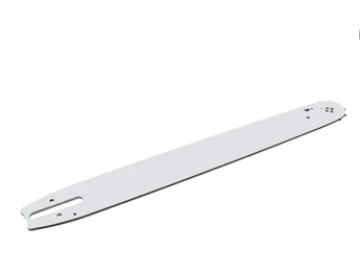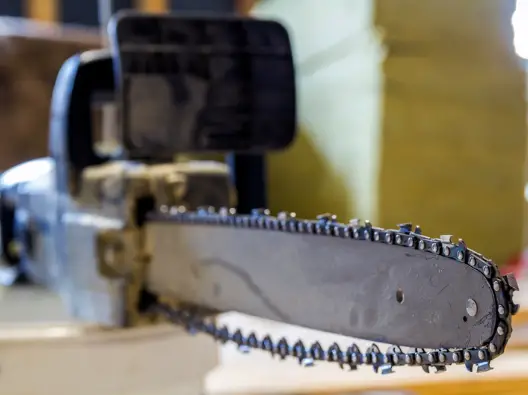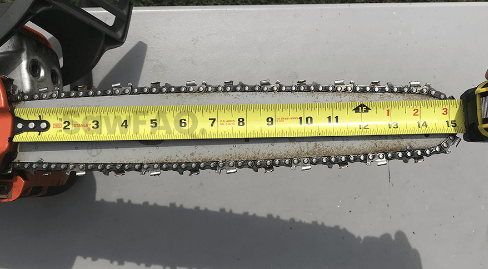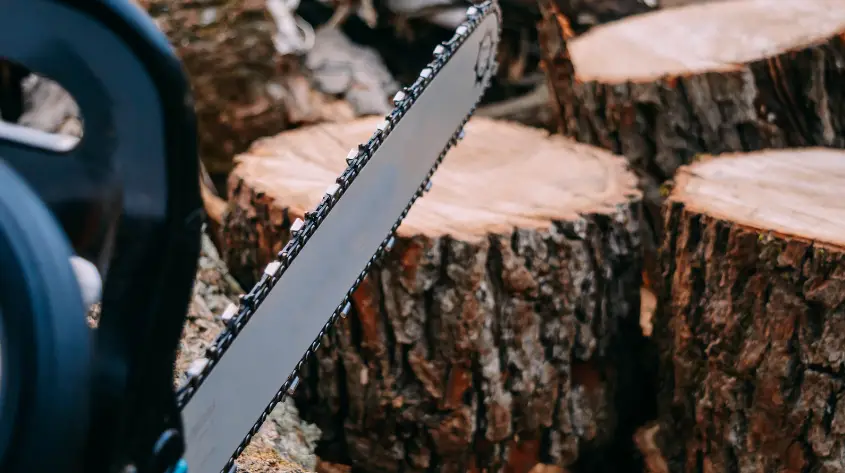Your chainsaw bar is a vital part of your chainsaw – without it, it simply wouldn’t be safe to operate. Equally, using the wrong chainsaw bar size when purchasing a replacement bar from a hardware store can also make your chainsaw unsafe.
What does all that mean?
It means, knowing how to measure chainsaw bar length is vital, because getting the length of the bar correct is the best way to ensure your new bar is right for your chainsaw, helping it work as it should, and helping keep you safe when operating it.
So how do you measure a chainsaw bar? Join us below and we’ll talk you through the whole process, so your replacement bar is sure to be the correct size.
What Does Chainsaw Bar Length Mean?
To understand chainsaw bars, you first need to understand their role in the chainsaw as a power tool.
If you didn’t know already, a chainsaw bar acts as a guide for your powerful saws, controlling the chainsaw chain – the item on a chainsaw responsible for cutting. Without a steady guide to hold its hand through the process, a chainsaw would be very difficult to use, even unsafe.
The chainsaw bar is sometimes referred to as the chainsaw guide or chainsaw blade, too – these are all the same thing.

How Is The Chainsaw Bar Different From The Chainsaw Chain?
The bar and chain work together to cut your wood effectively for your woodworking projects (whether you’re cutting down small trees and harvesting firewood or simply cutting up old furniture), but the chainsaw bar and chain are still different from one another.
Chainsaw chains are responsible for the actual cutting, and the chainsaw’s bar is responsible for guiding that cutting motion so you get the perfect cut to the nearest inch.

Why Is The Length Of A Chainsaw Bar So Important?
Getting the length of the bar right is very important. The chain bar is the most important component of any chainsaw, and they come in different sizes. As standard, chainsaw bars are usually between 8 and 24 inches, where small chainsaws have smaller bar lengths, and bigger chainsaws have a larger bar length.
To find out the exact measurement, you will need to consult your product manual or measure it yourself.
This is vital, because you need to ensure the chainsaw blade length is large enough to encompass the chainsaw chain, whilst also making sure it fits snugly so it can guide the chainsaw chain whilst cutting.
Different Ways To Measure A Chainsaw Bar
There are two ways of measuring a bar when purchasing a replacement chainsaw bar if you don’t have your user manual or box that the chainsaw shipped in to hand.
The first, and least common, is to measure a chainsaw bar from tail to tip. This is known as the full bar measurement or the true bar length. This tells you the entire length of the guide bar, but this information isn’t always useful or easy to get. Why? Because the entire length of the bar is much larger than it first seems, as the bar actually sits further back than the mounting slot you see as you’re using the chainsaw.
Instead, the bar goes further back and to take the full length measurement of the chainsaw bar, you’ll need to remove the bar from the body. We’ll talk more about how to do that below.
The second, and most common way to measure a chainsaw bar, is to focus on the effective cutting length. This only takes the measurement of the chainsaw bar from the tip of the chainsaw blade to the chainsaw body. The cutting length only focuses on the useful part of the bar that actually works with the chainsaw chain. When looking for a replacement chainsaw bar, you’ll typically need the effective cutting length size, rather than the full or true length above (but preferably them both together for a more accurate result).
Either way, we’ll talk you through both methods below.
How To Measure A Chainsaw Bar
Remember, today’s post is focussing on measuring the chainsaw bar, and the two methods we’ll discuss below are for the chain bar only. If you want to know how to measure chainsaw chains, this won’t be covered in today’s post, but we will be covering chainsaw chain size in a later post.
For now, let’s focus on chainsaw bars!
Safety First
- Pick out a flat surface to work on – ensure the flat surface is uncluttered and clean before you start
- Turn off the chainsaw – before you go anywhere near the chainsaw you’ll need to make sure there’s no chance of it switching on as you work, you can even remove the spark plug wire to be extra safe if you please
- Wear protective gloves to protect yourself from the chain’s teeth
- Take out your tape measure and have screwdrivers on hand for when you need to find out the true length measurement rather than the cutting length

An Obvious, Simple Trick
We’ll let you in on a little secret. If you have the model number, owner’s manual, or box, then finding replacement parts for your chainsaw is much easier. It’ll give you the information you need right away, without having to use a tape measure.
Information regarding your bar size, chain size, chain pitch, chain gauge, and everything in between can all be found in your owner’s manual, meaning you don’t need to waste time counting the number of drive links (for your chain), measuring the distance between three rivets (for the chain pitch), or measuring your chain bar (for your bar size) to find the info you need.
So, if you have your manual to hand, go and check it out. It’ll give you the effective length of your chainsaw bar right away depending on your size chainsaw and model. Every bar will vary depending on the chainsaw you use, so having information about your specific model is always helpful.
If you’re reading this tip too late and you still need to measure a chainsaw bar to find out the size, don’t worry. It’s still doable. Just remember to keep hold of your owner’s manual next time you buy electric chainsaws, so you don’t have to go through this again…
Chainsaw Bar Length: Cutting Length Measurement
Let’s start with the most common way to measure a chainsaw bar: the cutting length or called length. Thankfully, this is also the easiest method and the info you’ll need when looking for a new chain bar in your local hardware store, so this should always be where you start.
All you need to do here is take your measuring tape and measure the chainsaw bar from the tip of the chainsaw to the chainsaw body. This will give you the cutting length/called length and tell you the accurate measurement of the chainsaw bar in terms of what’s actually being used to help the chain cut through wood.
Once you have the number from your tape measure, you’ll need to round up the number to the closest inch. Chainsaw bars are sold in set lengths to fit each different chainsaw size, but it’s best to have a chainsaw bar that’s a few inches longer than it needs to be, than one that’s too small. The actual length (the number on your tape measure) doesn’t matter so much, it’s used more as a guide. So long as the chain fits within the slightly longer chainsaw bar, you’ll be able to make it work.
Remember, always round up – never round down when it comes to the length of the chainsaw bar!
Chainsaw Bar Length: Full Length Measurement
To take the full measurement or true length of the chainsaw bar, you’ll need to remove the chainsaw bar and chain from the chainsaw body to accurately measure the true length of the bar.
Step One: Remove Chainsaw Housing
To start with, you’ll need to remove the bar from the chainsaw housing or body. You can do this by locating the two screws at the base of the blade, and loosening them.
Step Two: Pull Chain From Bar
Inside the bar will be a tension wheel. Turn the screw here to loosen it so that the chain can be removed from the bar groove.
Step Three: Remove Chain
Once loose from every bar groove, the bar and chain can both be removed separate from one another.
Step Four: Check Bar
Check the bar for damage to see if a new one is necessary.
Step Five: Measure Now That It’s Free
Now that you have the full bar in your hands, place it on a flat surface and measure the full length of the chain bar. As you’ll see, this isn’t the same length as the cutting length from earlier – it ought to be bigger.
Here, you don’t need to round up the measurement either. When you measure the true length, you can get a much more accurate measurement since it’s free of the chainsaw and rounding up isn’t necessary.
Using Both Measurements
Now that you have the true length and the cutting length, you can actually use both of these measurements to find the bar with the perfect fit for your chainsaw.
When you pick up a replacement bar, you ought to notice two numbers on the packaging – these denote the true and cutting length, and you can compare them to the two measurements you took earlier of your old bar to make sure the new one is perfect.
Once you’ve found the perfect match, you can pick it up, take it home, and then install it – it’s as easy as that.
A Note On Measuring Your Chainsaw Chain
Once you’ve taken the chainsaw chain and bar out of the chainsaw body for the full measure of the bar, it can often be a good time for chain replacement, too.
Today, we won’t cover how to measure a chainsaw chain when buying a chainsaw chain because it involves knowing the chain pitch, chain gauge, and the length of the replacement chain, and that’s a whole topic in itself.
Stick around, though, and we’ll talk about chains and how to measure a chainsaw chain in a future article!
Final Thoughts
As you can see, the bar on your chainsaw has two measurements that aren’t the same length – but both numbers are still important. The cutting length is the easiest to find, but if you want to be extra accurate at the store when picking out a replacement, the true length is important to find out too.
Together, the two numbers will give you the perfect replacement bar for your specific model, and it’ll mean you can operate your chainsaw safely and with precision moving forward.


